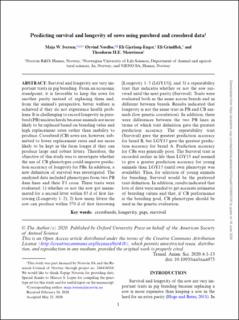| dc.description.abstract | Survival and longevity are very important traits in pig breeding. From an economic standpoint, it is favorable to keep the sows for another parity instead of replacing them and, from the animal’s perspective, better welfare is achieved if they do not experience health problems. It is challenging to record longevity in purebred (PB) nucleus herds because animals are more likely to be replaced based on breeding value and high replacement rates rather than inability to produce. Crossbred (CB) sows are, however, submitted to lower replacement rates and are more likely to be kept in the farm longer if they can produce large and robust litters. Therefore, the objective of this study was to investigate whether the use of CB phenotypes could improve prediction accuracy of longevity for PBs. In addition, a new definition of survival was investigated. The analyzed data included phenotypes from two PB dam lines and their F1 cross. Three traits were evaluated: 1) whether or not the sow got inseminated for a second litter within 85 d of first farrowing (Longevity 1–2), 2) how many litters the sow can produce within 570 d of first farrowing [Longevity 1–5 (LGY15)], and 3) a repeatability trait that indicates whether or not the sow survived until the next parity (Survival). Traits were evaluated both as the same across breeds and as different between breeds. Results indicated that longevity is not the same trait in PB and CB animals (low genetic correlation). In addition, there were differences between the two PB lines in terms of which trait definition gave the greatest prediction accuracy. The repeatability trait (Survival) gave the greatest prediction accuracy for breed B, but LGY15 gave the greatest prediction accuracy for breed A. Prediction accuracy for CBs was generally poor. The Survival trait is recorded earlier in life than LGY15 and seemed to give a greater prediction accuracy for young animals than LGY15 (until own phenotype was available). Thus, for selection of young animals for breeding, Survival would be the preferred trait definition. In addition, results indicated that lots of data were needed to get accurate estimates of breeding values and that, if CB performance is the breeding goal, CB phenotypes should be used in the genetic evaluation. | en_US |

